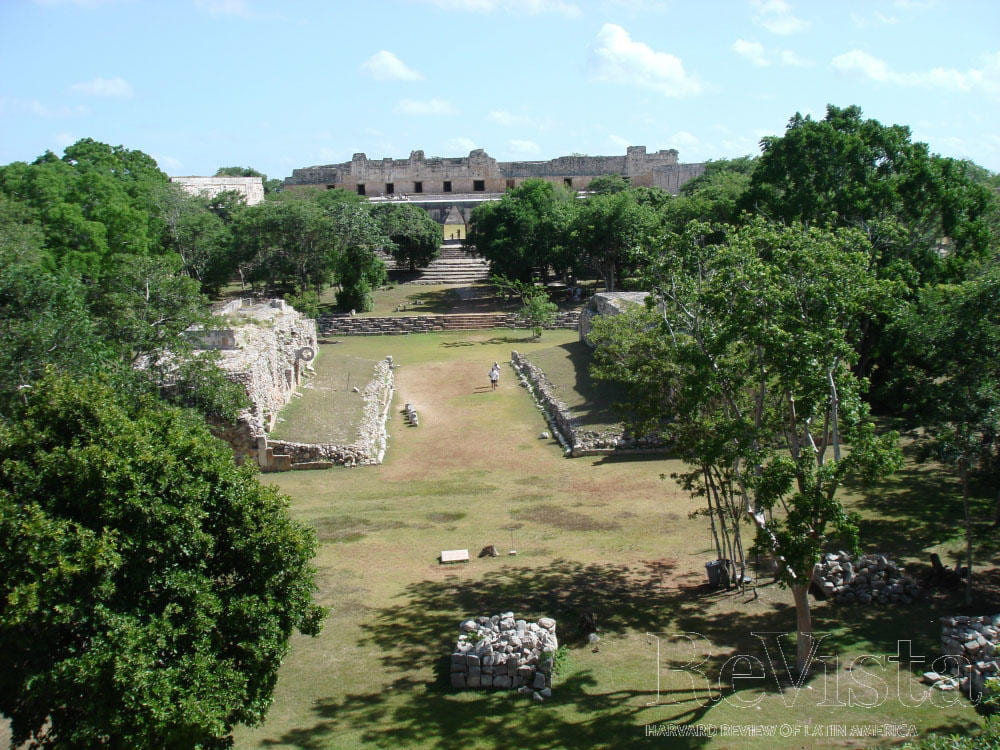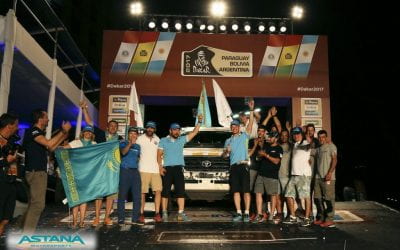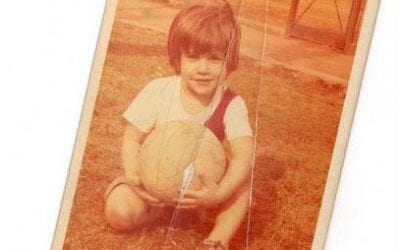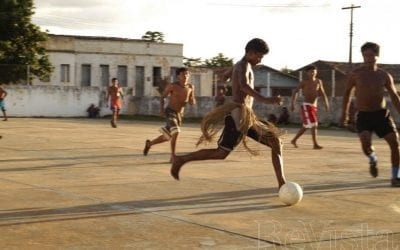“While the rest of the world was caught up in contests of individual athletic skills such as jousting, footraces, swimming and wrestling, New World cultures were fielding teams of ballplayers who competed against each other on specially designed courts” (Paul Kirchhoff, Mesoamérica, sus limites Geográficos, Composición Etnica y Caracteres Culturales, Acta Americana 1:92-107, 1943).
There were in fact many different kinds of rubber-ball games in ancient Mesoamerica, including stickball, handball and hip-ball (the one played in the masonry courts; Figures 1 and 2). After years of exhaustive research on the courts where the hip-ball game was played, Eric Taladoire succinctly summarized the rules of that game as follows:
“Two teams, consisting of between two and seven players each, faced off, separated by a centerline in the ballcourt…. The best players took positions along the alley, while others worked the end zones. They prevented the ball from going dead by deflecting it and sending it back to the other team. The ball was struck with particular parts of the body, such as the arms, shoulders, or buttocks. Players were prohibited from using their hands, feet, or head to hit the ball. This was probably a matter of safety, since a single blow from the heavy ball could injure or even kill a player. To protect themselves from the impact of the ball and the rigors of play, the almost naked players wore protective belts, gloves, and sometimes kneepads and sandals. Scoring was mainly the result of faults, as in tennis: touching the ball with a prohibited part of the body; failing to catch or to return it; or sending the ball outside the court. Due to the complex scoring method, games could last for long periods—sometimes the entire day” (Eric Taladoire, “The Architectural Background of the Pre-Hispanic Ballgame: An Evolutionary Perspective.” In The Sport of Life and Death: The Mesoamerican Ballgame, edited by E. M. Whittington, pp. 96-115. Thames and Hudson, London, 2001).
The longevity of the rubber ball game played in stone masonry courts was one of the diagnostic features of the Mesoamerican culture area that German-Mexican anthropologist Paul Kirchoff defined. Although a variety of ball games were played throughout the region, the hip-ball game holds the greatest fascination today (Figure 3). This is due in large measure to the rediscovery of the pertinent 15th and 16th Mexican manuscripts in libraries and other collections during the 19th century, which relay a wealth of ethnohistoric data on the subject of the hip-ball game (ollamaliztli, in Nahuatl) that was played in stone masonry courts (tlachtli). These accounts concentrate almost exclusively on the practical aspects of the game, such as the manner in which it was played, the high stakes of heavy gambling that accompanied it, and famous cases of Aztec disputes resolved—or not—on the playing alleys of ball courts.
Yet the deep-seated importance of religion and politics associated with the game also emerge from analysis of the Aztec accounts and other earlier sources, such as those from the Maya area. The sacrificial aspects of the ancient games are often sensationalized. This emphasis overlooks the archaeological evidence and historical accounts that indicate how ball games crossed social, ethnic and gender divisions, and sustained diverse ritual economies, constituting much more than “mere sport” for everyone in ancient Mesoamerica.
The imagery carved or painted onto the temples and playing alleys of the ballcourts suggests they served as the stage in which the players re-enacted cosmic dramas. Scholars agree that the movement of the rubber ball symbolized the movements of the sun and moon and thus tied the game to rituals promoting fertility and abundant harvests.
From major sites to small communities, the spectacle of the sport was a climax to festivals timed to both the calendar and politically charged events. People made pilgrimages to large sites with storied courts to be entertained and enthralled by the pageantry of mythological tales reenacted amidst a backdrop of these lively architectural settings.
The “cosmic” backdrop was appropriate because ballcourts were also often the setting for dispute resolution and war-related activities. Beyond reinforcing social status and rivalries, the games and courts in Mesoamerica also served as a means of maintaining political boundaries and settling disputes between communities.
The playing of the game and the wagers that accompanied it apparently served to resolve conflicts of various sorts among the Aztecs. Diego Durán reported in detail on the great stakes of the gambling surrounding the games in the Aztec Triple Alliance. This perceived “sin” was one of the principal reasons—along with the numerous injuries resulting from the game—that the Spanish friars outlawed it after the conquest (Fray Diego Durán, Historia de las Indias de Nueva España e Islas de la Tierra Firme, vol. I: 208-209, México, D. F. Editorial Porrúa, 1967).
The most famous tales of ball-game wagers that have survived also revolve around Mexica rulers. The Emperor Axayacatl tried to secure gardens in Xochimilco from its lord, Xihuiltémoc, betting his own market and the lake around it. Upon losing the game, he had his Xochimilcan counterpart strangled to death rather than lose such a treasure to a lower-ranking lord. When the Texcocan sage and ruler Nezahualpilli interpreted the appearance of a comet as a harbinger of the end of the Triple Alliance, his Mexica counterpart Moctezuma dared him to test his prophecy on the ballcourt. The Texcocan won the day and Moctezuma lost both the game and, eventually, his empire.
Significant wagering clearly had an impact on the exchange and manufacture of goods, and much of what drove styles of dress (such as feathers, jewelry, belts and sandals) was no doubt reinforced by the ballgame events and the dramatization of the costumes and paraphernalia associated with the game. The sheer amounts of goods needed to satisfy bets alone accounted for increased productions of textiles, featherwork, jewelry, and vessels, keeping the economy rich and many employed. Tribute lists recorded in manuscripts like the Codex Mendoza often show rubber balls and reflect these payments to some degree. Offerings and sacrifices associated with the ballgame were a means of imbuing objects with value and sacredness. Durán also mentions the numerous shrines and offerings left to patrons of both the ballgame and board games. Copal, flowers, candles, and blood sacrifices were left at these spots frequently in efforts to ensure a favorable outcome.
The patolli board game, a form of gambling played by the Aztecs, has antecedents in the Maya area, in the eastern third of Mesoamerica (Figure 4a). Our recent discovery of a series of patolli-like game boards scratched into the east structure’s floor of the earliest ball court at Copan attests to the important function this board game had as a ritual activity linked to the ballgame (Figures 4b, c). Likewise, among the Aztecs, the god Macuilxochitl (“Five Flower”) was the supernatural patron of both the ballgame and patolli. Both are associated with divination, yet both were the focus of heavy gambling. On the central playing alley floor marker of Ballcourt IIb (715 A.D.), we have identified the right-hand figure as the then-living king Waxaklajun U’baah K’awiil (Ruler 13 in the Copan dynasty of 16 sovereigns) dressed in the guise of an earlier, Maya version of the deity the Aztecs called Macuilxochitl, complete with the hand painted over the jaw that his later Aztec counterpart always bore (Figure 5). This identification suggests that Ruler 13 was identified not just as the patron of the hip-ball games, but of the divination and gambling that took place in association with them, in the very heart of the city’s sacred precinct.
For commoners and nobility alike, wagers ranged from jewelry to slaves to land. Indeed, even the personal liberty of the family and the gambler himself could be lost in a bet upon the outcome of a game. Much of the wagering has been likened by Vernon L. Scarborough to the kind of displays of status rivalry documented by the anthropologist Clifford Geertz in modern Bali cockfighting. Thus the acquisition and consumption of objects surrounding the game may have had an important “leveling” function in many Mesoamerican communities, from rural villages to the Aztec “Triple Alliance” empire.
Ceramic figurines depicting ballplayers throughout Mesoamerica show that the ballgame was a wildly popular pastime and likely played by both women and men as early as 1800-1000 B.C. (Figure 6; see Suzanna Eckholm, “Ceramic Figurines and the Mesoamerican Ballgame” in The Mesoamerican Ballgame, ed. Vernon L. Scarborough and David R. Wilcox, pp. 241-250, Tuscon, University of Arizona Press, 1991, and Douglas E. Bradley, “Gender, Power, and Fertility in the Olme Ritual Ballgame” in The Sport of Life and Death: The Mesoamerican Ballgame. ed. E. Michael Whittington, pp. 32-39, London, Thames and Hudson, 2001).
Fray Bartholomé de las Casas saw games played by women, possibly at Hispaniola. Classic Maya reliefs at Yaxchilan show royal women with the ball in one hand, indicating they indeed played the game, or put the ball into play. The popularity of the game across both gender and social divisions highlights the degree of exchange of locally manufactured ballgame-related goods and “souvenirs” which likely took place at every major contest.
It is clear that in addition to the highly visible ballcourts in the center of the sacred precincts of the larger cities, there were courts in the barrios and at the major markets as well. Large marketplaces at many ancient sites are often found in close proximity to ballcourt architecture for practical reasons. The two activities went hand in hand. Whenever there was a major ballgame, the festivities and consumption that accompanied it were important market events as well.
Harvard PhD John G. Fox made the important point that a great deal of feasting also took place in association with the games and the courts. He suggests that feasting fulfilled significant connective functions, both within and between communities (John G. Fox, “Playing with Power: Ballcourts and Political Ritual in Southern Mesoamerica,” Current Anthropology, 37(3): 483-509, 1996). The games staged by Aztec kings and nobles often ended with music and dance, according to both Durán and Bernardino de Sahagún in The Florentine Codex: General History of the Things of New Spain. 13 vols., trans. Arthur J. O. Anderson and C. E. Dibble, Salt Lake City, University of Utah Press, 1950-82 [Vol. IX: 299].
While the great public games carried on at the main courts of the largest kingdoms of Mesoamerica served to showcase the power and beneficence of the rulers who sponsored them (not unlike the Roman caesars and their “bread and circus”), these same integrative aspects functioned at much smaller sites, throughout ancient Mesoamerica. Virtually every community of any size in highland Guatemala had a functioning ballcourt in the Postclassic period (900-1519 A.D.), a testimony to its importance in that place and time.
For the Aztec era, the Spanish chroniclers document that many rulers had professional players in their employ and made arrangements for them to face off on important occasions. But the professional players were not well looked upon by everyone, because it was considered a vice to play ball for the purpose of betting. Despite this supposed shunning, depictions of the ballplayers in Sahagún’s masterwork show them in the company of different social classes, indicating the game was played and enjoyed by persons of all social positions.
Although the games played in the courts in the barrios, and next to the marketplaces, never ended in sacrifices, those in the great public contests that ended in death surely captured the imagination of the ancients as much as they do the sensationalist writers of our own place and time. There are numerous scenes of human sacrifice in post-game rituals depicted on ballcourt reliefs, most notably at Chichén Itzá, and in abundance throughout the Peripheral Coastal Lowlands of the southern Maya area, and at Tajín. It seems clear that by staging games that resulted in such sacrifices, the rulers of ancient Mesoamerican towns were intent on demonstrating their power over life and death. This power was clearly exercised both on their enemies and their own subjects alike. Indeed, at both Tula and Tenochtitlán, the skull rack for the heads of sacrificial victims (tzompantli) was constructed next to the principal ball court (Figure 7). This particularly graphic aspect of the architecture of the ball game stands as grim testimony of the duality of life and death associated with it. The public spectacles and the imagery that documented their denouements remind us that this form of ritualized combat, and the ideologies associated with both the public ball games and with warfare, had gripping and occasionally fatal consequences in the quotidian lives of people throughout ancient Mesoamerica.
Just as sporting events today continue to draw masses of spectators and are sources of economic enrichment for many segments of society, in ancient times any community—be it major city, aspiring town, or humble village—that hosted the event received an economic boost. Religious underpinnings of the ancient games were a driving force in the production, acquisition, and consumption of a wide variety of goods that satisfied the sacred and secular functions of the grand spectacles. Today’s contemporary ball games perpetuate these traditions established 3,500 years ago in the New World and their shops and stalls echo the lively ancient marketplaces and the vigorous economies associated with the ritual of sport, which satisfies the emotional and physical needs of people from all walks of life (see also Jane Stevenson Day, “Performing on the Court.” in The Sport of Life and Death: The Mesoamerican Ballgame. ed. E. Michael Whittington, pp. 64–77, Thames and Hudson, London, 2001).





